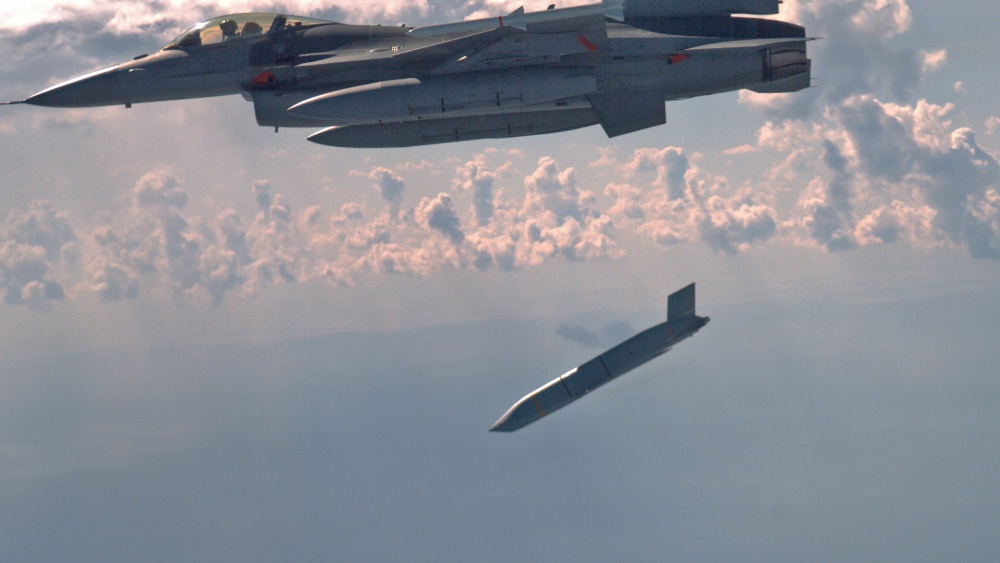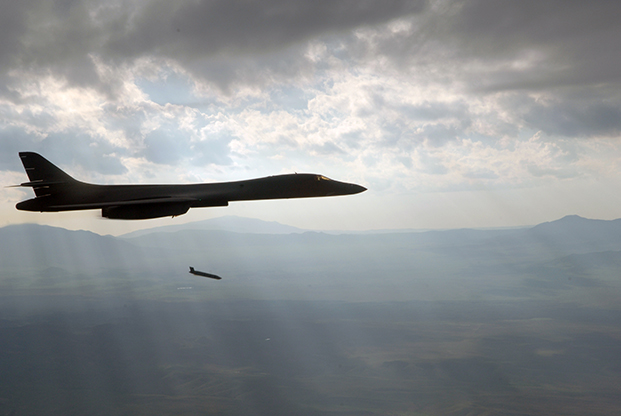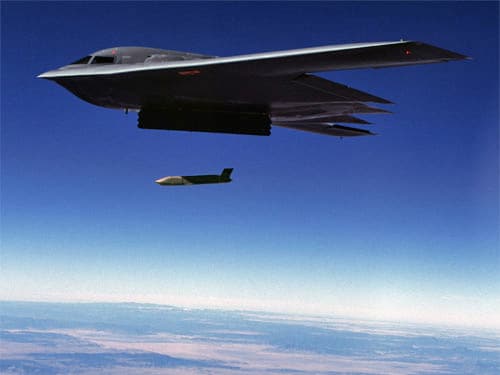US Air Force Details JASSM Improvements
[edefenceonline.com]
Few Major Points are
>>> At 14 ft. long and 2,250 lbs., the JASSM is an autonomous, conventional munition with a standoff range of more than 200 nautical miles. It is designed to defeat heavily defended, high-priority enemy targets deep behind enemy lines.
>>>The JASSM can be released in virtually any type of weather and uses its inertial-navigation system and GPS to find its intended target and then its infrared seeker for pinpoint accuracy just before impact. Once in the air, the stealthy cruise missile can reach high subsonic speeds at Mach 0.85. It is also equipped with an anti-jammer that keeps the enemy in its crosshairs regardless of their technology or capabilities.
>>>The newly christened JASSM program office was charged with not only making a high-survivability standoff weapon capable of attacking various types of targets, but also one made with speed and affordability in the acquisition world.
>>>While the JASSM has proven itself, the LRMSG has plans to make it even more lethal. The second phase of the program is to make an extended-range (ER) version of the weapon. The JASSM-ER will increase the standoff capability to more than 500 nautical miles. The weapon, which looks exactly the same as the original from the outside, has a new engine and can carry more fuel. It will first be integrated on the B-1B and will be ready for flight-testing later this spring.
>>>"A JASSM-ER will have the same lethality and stealth as a JASSM, but it will deliver that knock-out punch from more than twice as far away," said Lt. Col. Stephen Davis, JASSM Block 2 squadron commander. "In the simplest terms, this means some child's mom or dad won't have to fly their B-1 through enemy threats to strike many deeply placed targets."
>>>The LRMSG is also adding a weapons datalink that will enable key command-and-control elements to communicate with the weapon after it's already in flight. "The datalink will plug the weapon right into the warfighting network," said Michele Brazel, LRMSG deputy director. "They'll be able to track what each missile is doing in flight, retarget it in flight if need be, and then get a good indication of whether or not it destroyed its target."
>>>The JASSM is also scheduled to be one of the first weapons to be Universal Armament Interface compliant. UAI is a joint initiative that will allow the Air Force to incorporate new precision-guided munitions onto its aircraft without requiring major changes to each aircraft's software. New development activity is also planned to enable the JASSM to enhance its maritime engagement capability and become the air-launched weapon of choice, not only for highly defended fixed and relocatable land targets but moving maritime targets as well.
>>>"The United States desperately needed a first-day-of-the-war stealthy cruise missile that could go in and take out those threats that put our manned platforms at risk,"Gerry Freisthler, director of the Air Armament Center’s engineering- and acquisition-excellence directorate. "We needed something to go in and take on those double digit [surface-to-air missiles] that may be able to put our aircraft and aircrews at risk, and that's how JASSM came about.
*** FAIR USE NOTICE. This message contains copyrighted material whose use has not been specifically authorized by the copyright owner. It is being made available without profit to those who have expressed a prior interest in receiving the included information in their efforts to advance their understanding of arms trade activities, for non-profit research and educational purposes only.
[edefenceonline.com]
Few Major Points are
>>> At 14 ft. long and 2,250 lbs., the JASSM is an autonomous, conventional munition with a standoff range of more than 200 nautical miles. It is designed to defeat heavily defended, high-priority enemy targets deep behind enemy lines.
>>>The JASSM can be released in virtually any type of weather and uses its inertial-navigation system and GPS to find its intended target and then its infrared seeker for pinpoint accuracy just before impact. Once in the air, the stealthy cruise missile can reach high subsonic speeds at Mach 0.85. It is also equipped with an anti-jammer that keeps the enemy in its crosshairs regardless of their technology or capabilities.
>>>The newly christened JASSM program office was charged with not only making a high-survivability standoff weapon capable of attacking various types of targets, but also one made with speed and affordability in the acquisition world.
>>>While the JASSM has proven itself, the LRMSG has plans to make it even more lethal. The second phase of the program is to make an extended-range (ER) version of the weapon. The JASSM-ER will increase the standoff capability to more than 500 nautical miles. The weapon, which looks exactly the same as the original from the outside, has a new engine and can carry more fuel. It will first be integrated on the B-1B and will be ready for flight-testing later this spring.
>>>"A JASSM-ER will have the same lethality and stealth as a JASSM, but it will deliver that knock-out punch from more than twice as far away," said Lt. Col. Stephen Davis, JASSM Block 2 squadron commander. "In the simplest terms, this means some child's mom or dad won't have to fly their B-1 through enemy threats to strike many deeply placed targets."
>>>The LRMSG is also adding a weapons datalink that will enable key command-and-control elements to communicate with the weapon after it's already in flight. "The datalink will plug the weapon right into the warfighting network," said Michele Brazel, LRMSG deputy director. "They'll be able to track what each missile is doing in flight, retarget it in flight if need be, and then get a good indication of whether or not it destroyed its target."
>>>The JASSM is also scheduled to be one of the first weapons to be Universal Armament Interface compliant. UAI is a joint initiative that will allow the Air Force to incorporate new precision-guided munitions onto its aircraft without requiring major changes to each aircraft's software. New development activity is also planned to enable the JASSM to enhance its maritime engagement capability and become the air-launched weapon of choice, not only for highly defended fixed and relocatable land targets but moving maritime targets as well.
>>>"The United States desperately needed a first-day-of-the-war stealthy cruise missile that could go in and take out those threats that put our manned platforms at risk,"Gerry Freisthler, director of the Air Armament Center’s engineering- and acquisition-excellence directorate. "We needed something to go in and take on those double digit [surface-to-air missiles] that may be able to put our aircraft and aircrews at risk, and that's how JASSM came about.
*** FAIR USE NOTICE. This message contains copyrighted material whose use has not been specifically authorized by the copyright owner. It is being made available without profit to those who have expressed a prior interest in receiving the included information in their efforts to advance their understanding of arms trade activities, for non-profit research and educational purposes only.








